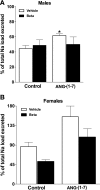Prenatal betamethasone exposure alters renal function in immature sheep: sex differences in effects
- PMID: 20554936
- PMCID: PMC2944426
- DOI: 10.1152/ajpregu.00590.2009
Prenatal betamethasone exposure alters renal function in immature sheep: sex differences in effects
Abstract
Synthetic glucocorticoids are commonly given to pregnant women when premature delivery threatens. Antenatal administration of clinically relevant doses of betamethasone to pregnant sheep causes sex-specific compromises of renal function and increases in blood pressure in adult offspring. However, it is unclear whether such effects are present in immature lambs. Therefore, the aims of the present study were to determine whether antenatal betamethasone at 80-81 days of gestation increases blood pressure and adversely impacts renal function in adolescent ewes and rams. Prenatal steroid exposure increased blood pressure significantly in the young male (84 +/- 2 vs. 74 +/- 3 mmHg) and female sheep (88 +/- 5 vs. 79 +/- 4), but it did not alter basal glomerular filtration rate, renal blood flow (RBF), or sodium excretion in either sex. However, antenatal betamethasone exposure blocked increases in RBF (P = 0.001), and enhanced excretion of an acute Na load (P < 0.05) in response to systemic infusions of angiotensin (ANG)-(1-7) at 10 pmol.kg(-1).min(-1) in males. In females, the natriuretic response to combined ANG-(1-7), and Na load was significantly altered by prenatal betamethasone exposure. These findings indicate that blood pressure is increased in immature animals in response to antenatal steroid exposure and that sex-specific effects on renal function also exist. These changes may reflect greater risk for further loss of renal function with age.
Figures








Similar articles
-
Gender differences in the effects of antenatal betamethasone exposure on renal function in adult sheep.Am J Physiol Regul Integr Comp Physiol. 2009 Feb;296(2):R309-17. doi: 10.1152/ajpregu.90645.2008. Epub 2008 Nov 26. Am J Physiol Regul Integr Comp Physiol. 2009. PMID: 19036827 Free PMC article.
-
Developmental effect of antenatal exposure to betamethasone on renal angiotensin II activity in the young adult sheep.Am J Physiol Renal Physiol. 2010 Apr;298(4):F847-56. doi: 10.1152/ajprenal.00497.2009. Epub 2010 Jan 13. Am J Physiol Renal Physiol. 2010. PMID: 20071463 Free PMC article.
-
Antenatal betamethasone exposure alters renal responses to angiotensin-(1-7) in uninephrectomized adult male sheep.J Renin Angiotensin Aldosterone Syst. 2013 Dec;14(4):290-8. doi: 10.1177/1470320312465217. Epub 2012 Nov 16. J Renin Angiotensin Aldosterone Syst. 2013. PMID: 23161144 Free PMC article.
-
Sex-specific effect of antenatal betamethasone exposure on renal oxidative stress induced by angiotensins in adult sheep.Am J Physiol Renal Physiol. 2014 Nov 1;307(9):F1013-22. doi: 10.1152/ajprenal.00354.2014. Epub 2014 Sep 10. Am J Physiol Renal Physiol. 2014. PMID: 25209867 Free PMC article.
-
Antenatal glucocorticoid treatment alters Na+ uptake in renal proximal tubule cells from adult offspring in a sex-specific manner.Am J Physiol Renal Physiol. 2015 Jun 1;308(11):F1268-75. doi: 10.1152/ajprenal.00047.2015. Epub 2015 Apr 1. Am J Physiol Renal Physiol. 2015. PMID: 25834069 Free PMC article.
Cited by
-
Update on the Angiotensin converting enzyme 2-Angiotensin (1-7)-MAS receptor axis: fetal programing, sex differences, and intracellular pathways.Front Endocrinol (Lausanne). 2014 Jan 9;4:201. doi: 10.3389/fendo.2013.00201. Front Endocrinol (Lausanne). 2014. PMID: 24409169 Free PMC article. Review.
-
Antenatal steroid exposure and heart rate variability in adolescents born with very low birth weight.Pediatr Res. 2017 Jan;81(1-1):57-62. doi: 10.1038/pr.2016.173. Epub 2016 Sep 15. Pediatr Res. 2017. PMID: 27632775 Free PMC article.
-
Sex differences in fetal kidney reprogramming: the case in the renin-angiotensin system.Pediatr Nephrol. 2024 Mar;39(3):645-653. doi: 10.1007/s00467-023-06112-8. Epub 2023 Aug 12. Pediatr Nephrol. 2024. PMID: 37572115 Review.
-
Increased susceptibility to cardiovascular disease in offspring born from dams of advanced maternal age.J Physiol. 2018 Dec;596(23):5807-5821. doi: 10.1113/JP275472. Epub 2018 Jun 21. J Physiol. 2018. PMID: 29882308 Free PMC article.
-
Prenatal Programming and Epigenetics in the Genesis of the Cardiorenal Syndrome.Cardiorenal Med. 2011;1(4):243-254. doi: 10.1159/000332756. Epub 2011 Oct 12. Cardiorenal Med. 2011. PMID: 22096456 Free PMC article.
References
-
- Armando I, Jezova M, Juorio AV, Terron JA, Falcon-Neri A, Semino-Mora C, Imboden H, Saavedra JM. Estrogen upregulates renal angiotensin II AT(2) receptors. Am J Physiol Renal Physiol 283: F934–F943, 2002 - PubMed
-
- Baylis C, Corman B. The aging kidney: insights from experimental studies. J Am Soc Nephrol 9: 699–709, 1998 - PubMed
Publication types
MeSH terms
Substances
Grants and funding
LinkOut - more resources
Full Text Sources
Miscellaneous

